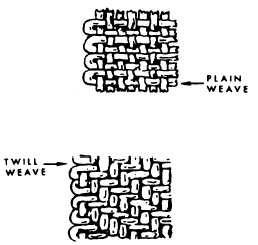239.367B
Figure 10-2.—Basic weaves.
are many, many different types of fabrics, or
cloth. When we say cloth, we mean any textile
material over 12 inches wide from selvage to
selvage.
The construction of cloth is determined by
many factors, such as tightness of yarn twist,
number of threads per inch, porosity of the yarns,
and the type of weave used in its formation. The
weave is one of the most important factors. The
two basic weaves are plain and twill (as shown
in figure 10-2). The plain weave is the simplest
method of weaving and gives the smoothest
surface of the fabric. It consists of the filling
threads passing over one warp thread and under
the next warp thread. The twill weave is a more
complicated weave in which the filling threads
pass over and under more than one warp thread,
thereby producing a surface on the fabric that is
generally recognized as a diagonal pattern.
Cotton
Cotton is a natural plant fiber, usually white.
The fibers or “staples” are between 3/8 and 2
inches in length. Chemically, it is almost pure
cellulose. Cotton fabrics, webbing, and tapes
absorb water readily unless treated. They dry
more slowly than the synthetic fabrics and are
more susceptible to mildew and fungus growth.
One should never ignore the presence of mildew
because it seriously affects the tensile strength of
cotton and other fabrics. Heat is less damaging
to cotton than to the synthetics. Insect damage
should, however, always be considered because
cotton is a food for certain cellulose-eating insects,
and cotton makes good nesting or cocoon-
spinning material for rodents and insects.
Nylon
This is a synthetic fiber of extreme toughness
and elasticity. It absorbs very little water, dries
quickly, is mildewproof, and is not affected by
most ordinary oils, greases, or cleaning fluids. It
is also mothproof. It is sensitive to some chemical
fumes, excessive heat, and direct rays of sunlight.
Nylon melts and drips when it is subjected to fire.
This characteristic requires that precautions be
taken when nylon is worn where there is a risk
of fire. Melted nylon on the skin can cause the
most serious of burns.
NOMEX Fabric
NOMEX is the trade name for a fabric that
is used in the construction of flight suits. NOMEX
fabric is a high-temperature resistant and
inherently flame-retardant synthetic fabric. This
fabric has no melt point or drip characteristics
when it is subjected to fire. NOMEX material is
light in weight, does not support combustion, but
begins to char at 700° to 800 °F. The fabric,
similar to nylon, is abrasion resistant, and is also
nonabsorbent.
Duck
This is a comparatively firm, coarse, plain-
weave, cotton fabric with weight per square yard
from 6 to 50 ounces. Duck is frequently called
canvas. It is primarily used in the construction of
protective covers because of its durability and
wearing characteristics.
Rubber and rubberized fabrics are used
in the manufacture of exposure suits and
flotation equipment because they are water-
tight. Rubberized materials are susceptible
to deterioration if subjected to heat and
mildew. Foam rubber is thick and resilient and
is used for padding in upholstery and aircraft
crash pads.
10-3

